Motorcycle.com

The scene is one that still, 38 years later, totally grips your attention.
In it, Steve McQueen, playing the original renegade SFPD detective Frank Bullit (Clint Eastwood as Dirty Harry would come a few years later), chases a pair of armed gunmen in a Dodge Charger with his bitchen' '68 Mustang GT until they crash in a fiery wreck. It's a perfect example of what happens when a bunch of gearheads have too much money and time.
We also remember a crazy guy named Evel who used a stripped-down, custom-framed Harley-Davidson XR750 flat-track bike to jump over great distances in front of thousands of screaming spectators. He filled the Houston Astrodome to
The 1960's and 70's were a dynamic time for Americans, filled with loud clothing and even louder cars, motorcycles and music.
There are plenty of you out there who ride because it reminds you of your youth; days when you had more hair on your head then on your back, when drugs were cheap and harmless and safe sex meant having a padded headboard. We can't go back to 99-cent lines of coke or unprotected sex, so what's a brother to do to re-live his glorious past?
Most of the "retro" bikes on the market are styled like big touring or drag-racing machines from the 30's, 40's or 50's, and choppers look cool but are almost worthless on the road.
For your edification, we rounded up two bikes evocative of the 60's and 70's most colorful characters. Steve McQueen is represented by Triumph's new-for-2006 Bonneville Scrambler--with authentic ISDT styling--and Harley's revised Sportster 1200R, with flat track-inspired styling and some serious performance features. The scene: the San Francisco Bay Area, location of Bullit and Knievel's famous 1973 crash (well one of them, anyway) at the Cow Palace. It's also the home of most-excellent MOron photographer Bob Stokstad and zillions of miles of great twisty roads to properly evaluate the two bikes handling and road manners. Managing Editor Pete Brissette and Senior Editor Gabe Ets-Hokin put some big miles on the machines to properly evaluate them in their native habitats.
Which is the best to play the heavy in your groovy, swingin' road fantasy, man? We're about to find out, so fluff up your Afro, don a suede vest and open a cold can of Tab. It's time for McQueen v. Knievel!
Act I: The Players
Even in 1968, Harley-Davidson's Sportster was getting pretty long in the tooth. It was first introduced in 1957 to replace the old "K" model and boasted such space-age advancements as hydraulic suspension front and rear, right-hand foot shifting, front brakes, and a 40 hp, 883cc overhead-valve motor. The XL models cranked out of the factory for the next 28 years before they were overhauled in 1985.
Evel, of course, rode an XR750, which looked like a Sportster motor but was far more sophisticated and powerful. However, the Sportster family has always been Harley's lightweight, performance-oriented streetbike, originally designed to battle the hordes of lightweight British bikes that were sapping Harley's domestic market and challenging them on the racetracks.
Today's Sportster has a mild family resemblance to those XLs and XRs of days past. Thankfully, it's been thoroughly redesigned-several times--to make it fast, smooth, comfortable and good-handling, traits for which the old Sportster is not known.
The most recent revamping was in 2002, and was very important for many reasons. It started with the frame; rather than solidly mounting the 45-degree vibe-ro-matic engine in a light frame, Harley's engineers took a cue from the Dyna and Buell people and used rubber blocks to isolate vibration from a new, heavier (and stiffer) frame. The result was a heavier bike, but also a motorcycle with which a rider could enjoy higher RPM-operation without going sterile or vomiting from excessive vibration.
High RPM operation? What are they smoking at Harley, anyway? Maybe nobody told you this before, but Sportster-and Sportster-ish motors like the XR-powerplants have been heavily used in all kinds of competition since Eisenhower was president, so the guys in Milwaukee know a thing or two about making these motors perform. In 1998, the 1200 Sportsters were given new high-compression (9.7:1), high-flow cylinder heads as well as a more aggressive cam profile to complement the 45-degree, pushrod-actuated two-valve-per cylinder air-cooled 1200cc powerplant. In 2007, miracle of miracles, Electronic Sequential Port Fuel Injection was added across the Harley-Davidson lineup.
Attached to the heavier, stiffer frame are some almost-modern suspension components. In back are the obligatory chromed shocks adjustable for preload and boasting 4.1 inches of travel. They locate a 13-spoke aluminum wheel (laced steel wheels are an option, don't worry) with a 150/80-16 Dunlop tire. The front 100/90-19 is pointed in the right direction by a pair of 39mm forks with 5.6 inches of travel.
Brakes are pretty space-age, too. In front is a pair of 292mm brake discs clutched by a pair of dual-piston calipers. The rear brake is also a 292mm rotor, except it uses a single-piston caliper. Those busy engineering guys reduced level effort by 14 percent as a bonus.
That's a lot of technology for any bike, but it's a lot of weight and money for what used to be an entry-level machine. Can the Triumph challenge it?
A Proper Bit of Kit: 2006 Triumph Scrambler
When our two editors were but mere gametes, British motorcycles-but mostly Triumphs-were the bike of choice for many sporting motorcyclists. Now, not so much. We buy motorcycles that are highly evolved and engineered to fit a specific niche.
What's inside this raccoon? Triumph is now using the air-cooled, dual overhead cam parallel-twin 865cc motor we first saw in the Thruxton 900. It has a 90mm bore and a 68mm stroke and uses four valves per cylinder; pretty modern for a r
The chassis is similarly counter-revolutionary. There's a tubular steel cradle that mounts the engine between pretty conventional suspension; 41mm non-adjustable forks in front and adjustable twin shocks in back. Braking is handled by a single 310mm disc with a twin-piston caliper in the front, a 310mm disc with a single-piston caliper in back. The tires are cool desert racer-esque semi-knobs, a 100/90-19 front and a 130/80-17 rear. Spokes n' inner tubes? Of course!
It's finished with that cool, hand-painted 4.4 gallon tank, black-finished mock oil tank sidecovers and a big, polished handlebar. There's lots of chrome and even a pair of rubber pads to help your artificial knees grip the tank.
Nobody can deny that the Scrambler has the retro looks nailed down. But will it perform well enough to keep Steve ahead of Evel?
Act II: The Test
They rode up and down hills, on all kinds of twisty backroads in four counties and even attended a dirt flat-track for some practice. At the end of it all they were able to pack up the truck and send Pete home with a good idea of which bike they'd like to own if they had to purchase one with their own money.
Sand Hill Ranch
Flat Track racing. He told me he had a friend who had been injured (go figure!) and was offering his race bikes up to whomever wanted to try out some racing.
John is a member of Team Slideways, a loosely-organized group of enthusiasts who pit together and drive each other to the hospital after races. Rider Randy Kremlacek offered up the bikes, so Pete and I arranged to spend an evening at the practice facility at Sand Hill Ranch.
Sand Hill Ranch is a privately-owned facility in Brentwood, CA, about 70 miles east of San Francisco.
Flat track is different from other forms of dirt competition. The track is kept groomed and flat, and as the practices and races progress, the hard clay becomes as grippy and smooth as asphalt on certain parts of the racing line. It's called the "blue groove", which I previously thought was a jazz recording label. In a "TT" setup, the course continues in the infield with some more twists, bumps and a jump or two.
We arrived at dusk on a Friday evening--flat track practices are only held Friday evenings from five to 10 PM--hoping to maybe slide around a little for photography on the two bikes in this test. Unfortunately, we could only manage a few quick static shots of the Harley on the track, but we were consoled when we met John and the rest of the Slideways crew. They had brought some gear for us in addition to some track-prepped XR100s and other bikes to ride on the track.
Of course, since I was by far the slowest guy at the practice, maybe "rail" isn't the best term. It seemed fast to me, but then Pete got out there. He proceeded to pick up the activity much better than I did, and by the end of his first session he was not the last guy. Third from last, but that's progress.
The AMA has local competition for flat track in all classes, ages and skill levels, and I hope to try my hand--or my foot--at some hotshoe work in the future. Dirt tracking doesn't have the high-flying "X-Treem" action of motocross or the triple-digit speeds of roadracing, but it is challenging, fun and all-American. Thanks to John, Randy, Sand Hill Ranch and everyone else who made us feel welcome in your sport!
-Gabe Ets-Hokin, Senior Editor
Plopping onto that flat saddle and staring at the white-on-black Smiths-like gauges while holding that wide bar is a trip to the past like nothing else on two wheels--short of an actual old Britbike project--can provide. Functionally it's pretty good, too, with a comfortable seat, a natural reach to the bars and the pegs right under your thigh where you expect them. It's good for passengers, too; "on a short around-town ride my girlfriend couldn't have been happier with the wide and comfortable seat", reported Pete. There's no carb-tickling or any other such nonsense; just stab the starter button and go. The motor whirs to life and settles into a familiar parallel-twin idle. It revs quickly, with a nice sound emanating from those flashy, high-mount mufflers.
You also get a lot of wind blast highway speeds, and although it's comfortable enough for the long haul with that nice big seat and upright seating, this is no tourer.
Around town it's much better, with a low seat and decent turning radius making it easy for short folks to handle, and that responsive motor zipping us from light to light. The long-ish travel suspension and light (compared to the Harley) weight made San Francisco's tracks, divots, bumps, potholes and gratings almost tolerable. No wonder Triumph has such a long history in San Francisco.
Brakes are serviceable, but don't really stand out. Like period binders, they require a decent squeeze and don't offer much in the way of feel, but at least they're not drums, right? "Less-than-modern brakes just mean you have to plan ahead and hope for the best" said Gabe, who has spent a lot of time on vintage bikes.
"Bad-ass looks" says Pete--the 1200R is a mean-looking motorcycle. The black engine treatment gives the big V-twin a hulking, menacing appearance, and everything else is low, long, or just plain purposeful. It still has all the styling cues Sportsters have had since the '50s; chrome fender supports, chrome headlight hood, and the peanut-shaped fuel tank. It looks lean, mean and right.
Ergonomically it's not the same as the Triumph but is familiar to anybody who's ridden a Sportster in the last 50 years. The seat is low and narrow, with the air cleaner awkwardly bumping your right knee. The handlebar is high and wide, but not uncomfortably so. Footpegs are further forward and higher than what youngsters brought up on Japanese sportbikes and standards might like but still put the body in a good, comfortable position.
The bike just hauls ass everywhere and is a hoot to ride in heavy traffic. The guy on the Triumph will be struggling to keep up as your roar up on-ramps and weave through rush-hour traffic. The decent brakes-at least as good as the twin-disc, twin-piston caliper systems on Japanese machines-and the bike's low, heavy, solid feel give you confidence at high speeds, even if wind blast becomes a substantial annoyance at the very high speeds this bike can comfortably cruise at.
Around town, the Sportster really knows how to cruise. That torque gets you from stoplight to stoplight in record time, and you can squeal and howl that back tire easily, thanks to cruiser-esque weight distribution and the skinny rubber. Up and down the many hills of Baghdad-by-the-Bay, the 1200R would rip to the top in second gear, even on the 18.5 percent grades, while the Scrambler would be bouncing between first and second. The low seat and good turning radius was helpful parking and turning around in the City's narrow streets, too. It did suffer-or rather the rider suffered-somewhat due to the shorter suspension travel on the many bumpy, broken bits of pavement scattered around town, nullifying the Sportster's speed advantage.
So on a twisty road, both bikes have their limitations; the Scrambler by its softish suspension and soft motor, and the Harley by its cantankerous, unsporting chassis geometry and limited cornering clearance. It means that a person who favors American-style riding can go as fast as the cat on the Scrambler adopting that smooth and flowing English riding style. It's true of the Brits themselves; they seem to work very well until they become unhinged.
For daily living, both bikes have pros and cons. The Triumph is more comfortable, handles better and is better with a passenger. The Harley is faster, gets better fuel economy and has incredibly low maintenance costs.
Living With the Tough Guys
A minor service-recommended for every 6,000 miles-will run a customer at Munroe's about $150 for labor and roughly $50 in parts. A major service-every 12,000 miles-is $440 in labor and about $100 in parts; this of course can vary depending on condition of the bike and parts costs.
The Harley needs servicing every 2,500 miles, according to Ray at Dudley-Perkins Harley Davidson. At 2,500 miles a Sportster owner can count on paying $175 for parts and labor, at 5,000 miles it's $355, and at 7,500 miles she gets socked for $565. At 10,000 miles the cost goes back to $175 so the custome
However, a home mechanic would have less fuss and bother with the Harley's self-adjusting valves and zero-maintenance drive belt. In addition, Harley-Davidson parts are very inexpensive. The Scrambler has some authentic touches technology-wise, like a drive chain and a petcock fuel-filter, but the valve train uses shim-under-bucket adjusters. That means they only need checking every 12,000 miles, but if any are out of adjustment it might be too challenging a job for most home mechanics.
The Harley has no helmet lock or tool kit; the Scrambler boasts as a tool kit a single allen wrench under one steel
Fuel economy was remarkably similar for both bikes, although our testers didn't do a lot of freeway riding. Expect the Harley to get 50 MPG or more on long freeway stints, with the Scrambler getting around 40. Around town they both dip into the high 30's.
Act III: The Conclusion
In terms of performance, the Harley was the clear winner for both our testers. It seems unfair to Triumph to not compare the Scrambler to the 883, but the 1200R is only $896 more than the Scrambler and just $900 more than the 883R. We don't think a prospective Scrambler/Sportster buyer would opt for the 883R; these are experienced enthusiasts who seek value and performance and would happily shell out the extra money. Therefore, comparing the 883 to the Scrambler would be equally unfair; more people would choose the 1200R, in our opinion.
However, we were loath to assign a winner to this shootout at all. It's really about a look, a feel, cruising around in a beautiful place on a distinctive, special bike. Either one of these bikes will make you feel good, either one will get you noticed.
You just have to choose if you want to be McQueen or Knievel, unless you're inspired to write your own history.
Nits and Notes
Harley:
An item that could use a redesign is the right foot peg. After looking at some photos of Gabe and Pete riding the Harley, we noticed that both of them were resting their right foot on part of the peg mount, which seemed more natural, rather than the peg itself. Putting a foot in the "correct" position just didn't feel right; like "straddling a farm horse or something", according to Pete.
Triumph:
Even without looking into the specs and details behind the engineering of the Scrambler's unit-construction motor, anyone could tell that it is thoroughly modern just by the smooth, trouble-free shifting.
Pete would like to see some taller gearing on the Scrambler. It's down significantly in power and torque to begin with, but he "can't help but think that being able to stretch first gear out a little more might at least help the rider to perceive it to be faster."
Epilogue: What I'd Buy
When I first learned that Gabe wanted to do a two-bike test with the spirit of Steve McQueen and Evel Kneivel and their bike brands of choice as a loose premise for the comparison, I was stoked. I thought to myself, "With the streets of San Francisco as the backdrop and a Triumph designed to herald days gone by, this may be one of the best tests I'll ever be involved with!"
Of the Harley I thought, "Eh, it's probably just another Harley. Reliable and torquey, but nothing special."
The best thing I can say about the Scrambler is that it's a great looking, quaint motorcycle.
In the famous words of Gomer Pyle, "Well, surprise, surprise, surprise!" Man, was I backwards in my thinking. Indeed, this was one of the best tests I've done to date. The weather was supreme and 'Frisco was, to say the least, a welcome change to our usual Southern Cali testing grounds. But talk about a change in attitude. Riding these two bikes was eye opening. I had visions of myself flying through the air to freedom while aboard the Scrambler. The last bike I expected to launch, effortlessly I might add, was a Harley-Davidson. As you can tell by a number of the photos I was wrong.
Neither of these bikes really tout "performance" as a primary characteristic. Sure, the Sportster is utilizing high-flow heads, but if you're honest with yourself the image that comes to mind when most people think of performance from a Harley is pavement-twisting torque rather than a canyon dancing. And the Scrambler, well let's just say that performance in this case is more about its modern day reliability instead of speeding or braking hijinks. But we knew that going in.
There'll be those that cry foul when comparing displacements, proclaiming that the vast gap in cubic centimeters gave the Harley an unfair advantage. Indeed, the Sporty's power is nothing short of impressive. But what separates the wheat from the chaff for me is the retail cost of each bike. Wait, I take that comment back, somewhat. The Harley out-powered, out-steered and out-braked the Scrambler, and it was more comfortable. Of course it had far worse ground clearance than the Triumph, but what Harley wouldn't?
Certainly the Triumph did well enough in the corners, but thanks to its unadjustable, long travel suspension it would eventually wallow if pushed too much. We shouldn't give much more praise to the Sportster. It was perfectly smooth on most surfaces, but the minute I encountered any high-speed bumps, my kidneys were the victims if I wasn't launched out of the saddle first.
The best thing I can say about the Scrambler is that it's a great looking, quaint motorcycle. Other than that I can't fathom why someone would pay $7,999.00 for a bike whose biggest technological attributes are a throttle position sensor and digital ignition. For a mere $896.00 more, you can have a bike with almost twice the horsepower and torque, fuel injection, a maintenance-free belt drive and a comfortable riding position.
If I were dead-set on spending eight grand on a motorcycle and didn't want a Harley, I would scout out a 35-year old original Bonneville, oil leaks, dodgy wiring and all, time and again to get the original character that the Scrambler can only hope to emulate.
-Pete Brissette, Managing Editor
I really wanted to be the Six Million Dollar Man in kindergarten.
I was much smaller than most of my classmates and lacked any semblance of athletic ability, so of all the 70's icons, one that could be artificially given instant superhuman strength and prowess was the most appealing to me. Unfortunately, he didn't have a motorcycle, so we're stuck with these guys.
It's such a good bike that had it gone against the bike we originally wanted to pit it against--the Sportster 883R-it would have emerged as the clear victor. I rode a 2006 1200R, and even that bike would have been squished by the sheer functional goodness the Scrambler offers. However, the 2007 was all that Harley had, and it's only $896 more than the Triumph, so in our minds it was a fair comparison.
"It's probably the best stock Harley Davidson product I've yet experienced..."
For that $896, you get a lot more power, fuel injection, and remarkably sorted handling and brakes. It's probably the best stock Harley Davidson product I've yet experienced and I think anybody would agree that it's just better to ride than the Triumph. I'm cringing because Triumph was reluctant to participate in a test where the competition would get an extra 300-plus cc of engine displacement, but now that we've tested the bikes, we have to tell the truth for the sake of whatever journalistic integrity motojournalists pretend to have. So sorry, Triumph, you can take us off the Christmas card list, but in the end I'm like any other consumer; I want value. The performance the Sportster 1200R offers is good for the money (as long as you aren't considering a Japanese supersport as well), and it drips with almost as much cool and bravado as the Scrambler.
I guess I'll just have to fantasize about jumping busses rather than the Swiss border. Buh-nuh-nuh-nuh-nuh-nuh!
--Gabe Ets-Hokin, Senior Editor
Apparel:
Gabe wears his Shoei RF-1000 helmet with Fog City anti-fog shield, Shift Denim Kevlar Street Pants, Lee Parks DeerSports Tour gloves, and the Piece de resistance, the Aerostich Fallstaff Waxed Cotton Darien jacket, which he will feature in an upcoming review as soon as it starts raining.
Pete just wears the same tired schmattas he always wears, with the exception of his very slick Harley-Davidson FXRG-2 Boots and a leather jacket that he claims is "of dubious origin". The helmet is also an RF-1000.

Motorcycle.com presents an unrivaled combination of bike reviews and news written by industry experts
More by Motorcycle.com Staff





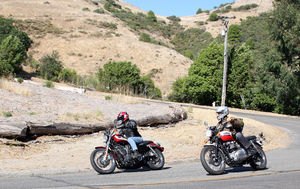



































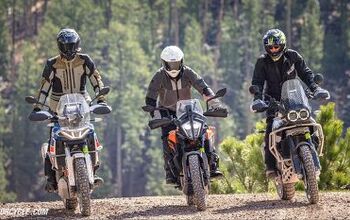
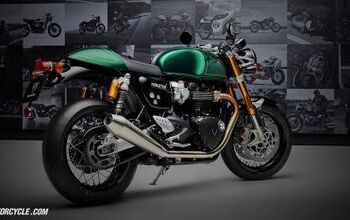
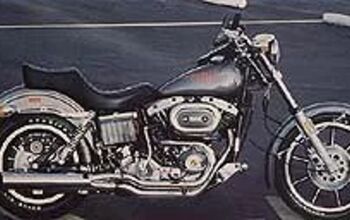

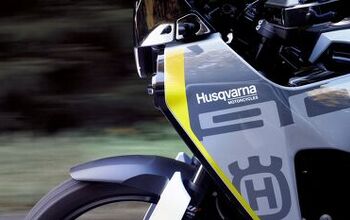













Comments
Join the conversation